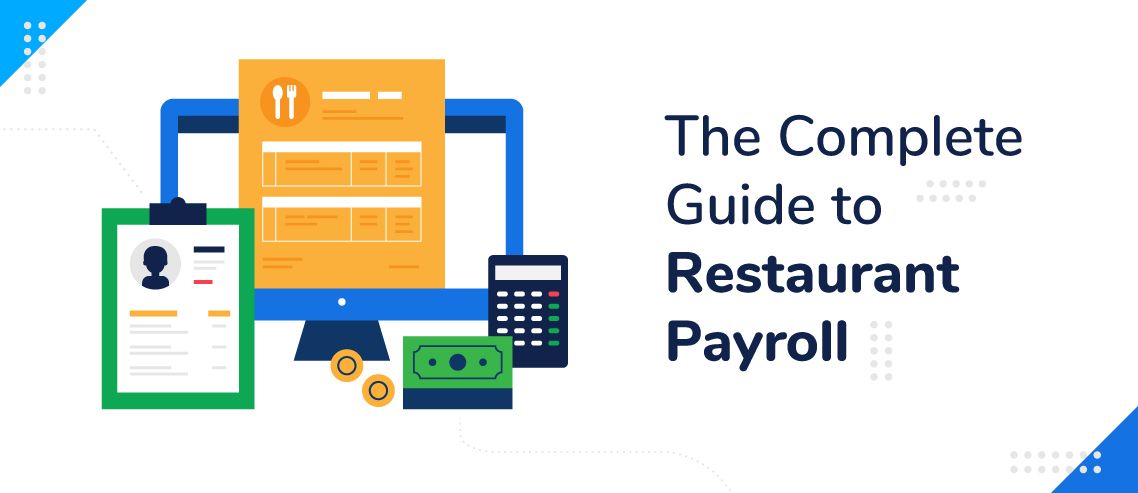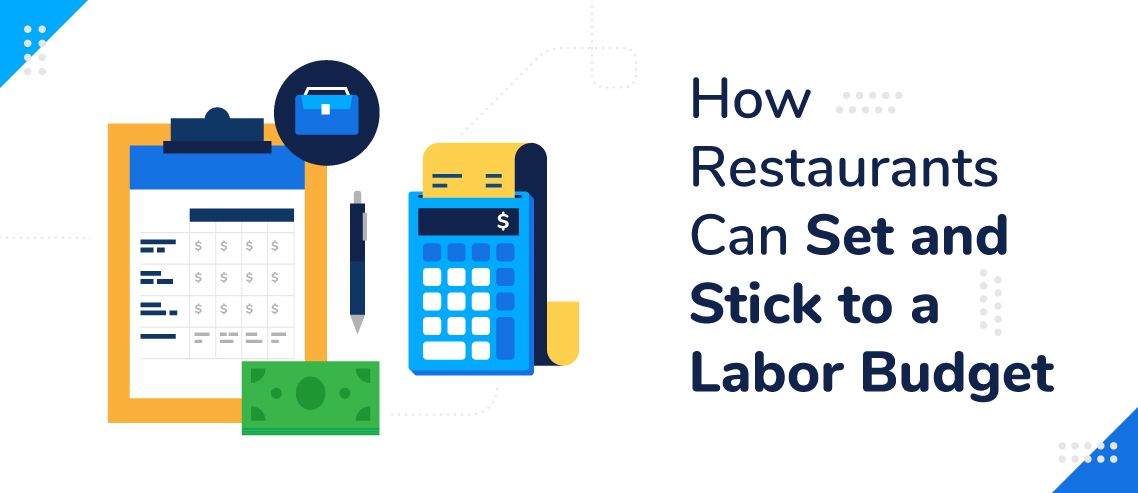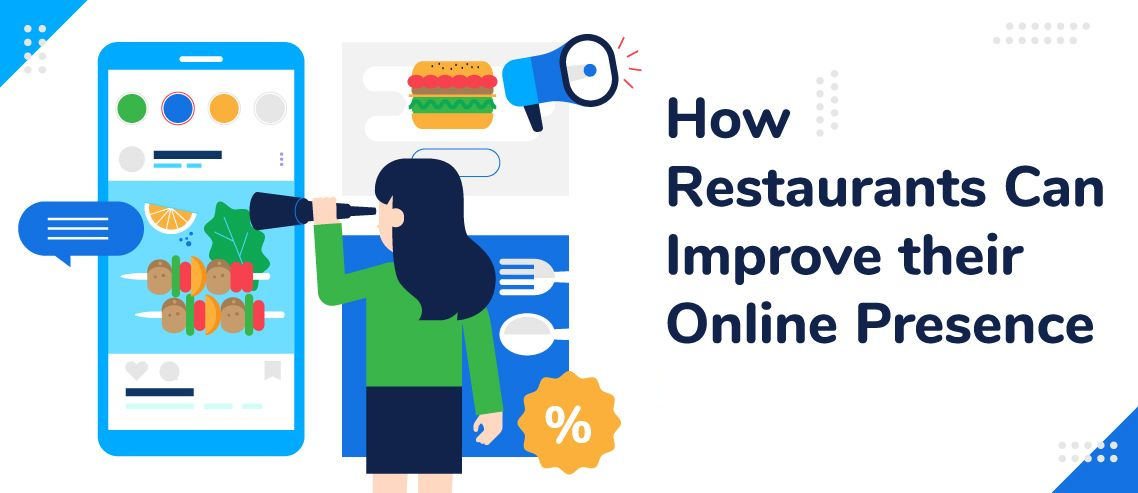How to create a restaurant marketing plan [+ Free template]

Your food can be the best anyone’s ever tasted and your service can be impeccable, but if you don’t have any customers, your restaurant will only last as long as an ice cream cake in the sun. That’s why you need a marketing plan.
To truly wow customers, create lines and open up the possibilities of franchising or opening new restaurants, you need a rock-solid marketing plan. We explain exactly how to create one that gets people talking about your restaurant and excited to visit and come back again and again.
What is a restaurant marketing plan?
A restaurant marketing plan is a document that outlines your plans to market your restaurant, bring in new customers, and enhance your guests’ experience. Shorter forms can be part of your business plan, but since it’s a working document that focuses on a specific time period, it may be best to keep it as an addendum to make editing easier.
With new restaurants opening every day and one of the highest risks in small business, it’s imperative that you have a plan to fill tables every day of the week. Your restaurant marketing plan helps you do just that so you can keep filling bellies for the long haul.
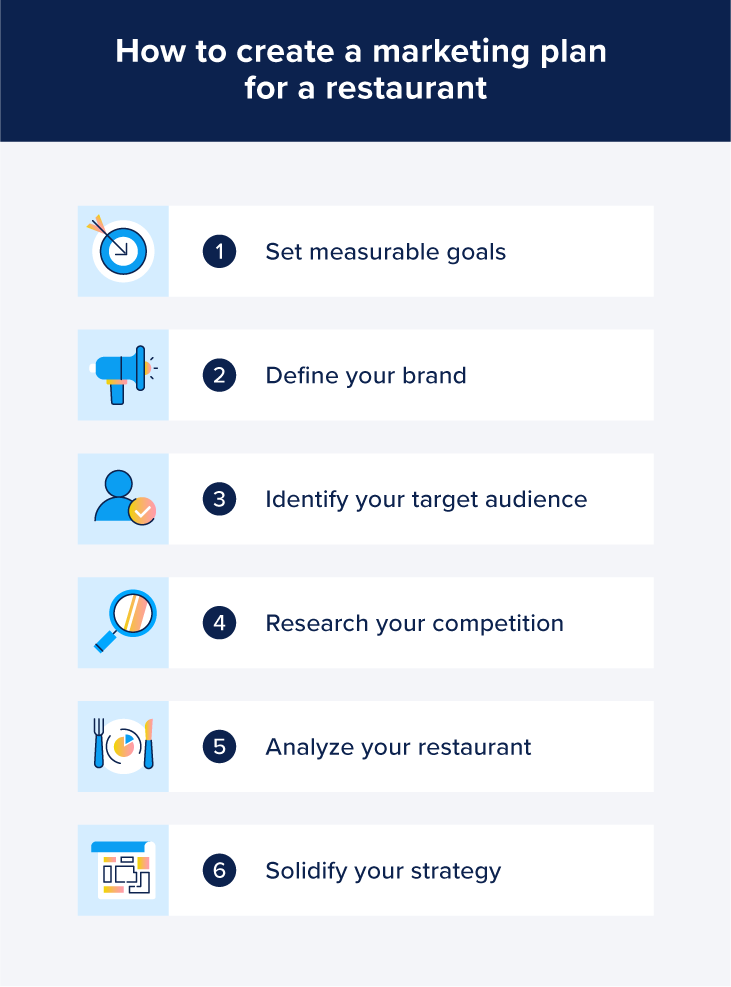
How to create a marketing plan for a restaurant
Before you start working on your marketing plan, you’ll want to ensure you already have your restaurant business plan and annual budget handy. You should create your marketing plan before opening your restaurant, but then update it as your restaurant grows.
Follow these steps to make a strong restaurant marketing plan.
1. Set measurable goals
The first step of any strong marketing plan is identifying what you hope to accomplish with your marketing. So spend some time brainstorming a mixture of short- and long-term goals. Maybe you want to increase your business during the lunch hour, or maybe you want to expand your repeat customer base. Don’t worry about making them specific or whether they’re achievable at this point — just get all your dreams down on paper when you brainstorm.
Once you’ve got a list, review it and pick the goals that seem the most important, and rewrite them as SMART goals:
- Specific: explain exactly what you hope to achieve and how you’ll do it
- Measurable: describe how you will track progress toward this goal
- Achievable: ensure your goals are something that you can achieve with your current resources
- Relevant: connect the goal to the big picture
- Time-bound: identify a deadline for the goal
2. Define your brand
If you’ve crafted a business plan already, review the following:
- Mission statement: a formal statement (usually 1-2 sentences) that defines the restaurant’s purpose for existing
- Vision statement: a formal statement outlining where you want your restaurant to go in the future
- Value proposition: a concise explanation of why a customer should choose your restaurant over the competition
- Positioning statement: a brief description of the benefits of your restaurant
If your restaurant marketing plan is separate from your business plan, it’s worth restating them. Otherwise, just refreshing your memory will help with the following steps.
However, if you haven’t written your business plan yet, now’s the time to draft these.
3. Identify your target audience
Put yourself in the shoes of your target customers. Who do you envision will be your main customers? Look into their demographics (objective facts about a person or group of people), psychographics (objective data about a person or group), and behaviors.
Ask yourself:
- Are they active on social media? If so, where? And how do they use it?
- Are they likely to consult online reviews before they eat somewhere? Will they write reviews?
- Would they rather dine in, order take out, or use a delivery service?
- What events do they participate in?
- Are they motivated to choose a restaurant based on coupons or special offers?
Once you know the answers to those questions, you can start thinking about what marketing strategies fit your target audience.
4. Research your competition
Choose three to five competitors in your community and conduct a competitive analysis to learn what works and what doesn’t. Look at their websites, social media channels, etc.
A SWOT analysis can help you do this quickly and accurately. Look for your competitors’:
- Strengths: What do these restaurants do well?
- Weaknesses: What do these restaurants need to improve?
- Opportunities: How can you take advantage of their weaknesses?
- Threats: What do these restaurants offer that you can’t?
Once you know the answers, you’ll better understand the marketing you’ll need to do to compete with the other restaurants in your area.
5. Analyze your restaurant
Repeat the SWOT analysis on your own restaurant. Use that information to identify your advantages over competitors and draft a unique selling proposition that capitalizes on it. Maybe your restaurant has lower prices or a more appealing atmosphere. Whatever it is, capitalize on what makes your restaurant stand out.
The SWOT analysis will also help you identify potential areas of weakness. Craft a plan to proactively address those weaknesses.
6. Solidify your strategy
Once you’ve done your research, look back at your goals, audience, and budget. Then identify one to three marketing strategies to make a priority for the next period. Describe what you plan to do and how you’ll accomplish it.
Here’s a quick breakdown of the different marketing strategies you’ll want to consider.
Website and SEO
If you haven’t already, you’ll want to prioritize creating a website. Most people Google restaurants to find their address, phone number, or read reviews. Without a website, many people will assume you don’t exist or you’ve closed.
At the very least, your website should include your menu, address and contact information, and hours. A blog with original content can also drive traffic to your website and increase conversions.
Whatever you put on your website, ensure it is optimized for mobile and desktop browsers and satisfies targeted keywords for the restaurant business.
Social media marketing
37% of restaurant patrons consult social media when looking for a new place to eat, so getting active on social media should also be a priority. It can be overwhelming to jump into social media, so concentrate on the channels your audience is present on. The big three are Facebook, Instagram, and Twitter.
Use Facebook to create customer relationships, post announcements, and share promotional materials. New menu items, contest information, videos and photos are all great content to share on Facebook, and you can also experiment with paid advertising on their platform.
Instagram is best for sharing photos, engaging with customers, and spreading your brand or culture to potential customers. Show off your delicious food with images, behind-the-scenes and time lapses videos. Share customer and partner profiles and show off your restaurant culture with video and event photos.
Twitter makes a great customer service and communication tool.Enhance your strategy by utilizing Twitter video tools to share promotional information, link to blog posts, and other content, and engage with your followers, especially regarding any customer service-themed comments. It’s also great for sharing timely updates, like if you have to close unexpectedly due to a power outage.
Reviews
At first glance, restaurant review sites may seem like a place for customers to talk about their experiences, but they actually function more like advertisements. People often visit review websites before deciding what restaurant to eat at, and even a half-star difference can cost you 27% in sales.
So it’s important that you establish your restaurant on review sites like Yelp and FourSquare and engage with your customers. Claim your business page, optimize it with photos and updated information, and respond to reviews. Say, thank you to people who write positive reviews and be respectful to people who leave a negative review. Engaging in this way shows potential customers that you care about people’s experiences at your restaurant.
Email marketing
Email marketing is the new version of direct mail. Use it to send newsletters updating recipients about what’s happening at your restaurant and share incentives like coupons. It’s also a great way to follow up with customers and ask for a review after they place an order online.
But don’t overdo it — aim to email at least once a month, but never more than once a week. You want to remind customers you’re there without annoying them with spam.
You’ll need to figure out a way to collect customers’ email addresses to do this effectively. Be creative — run a contest asking them to leave their business card (which usually includes an email address) or ask them for their email to get a unique discount code.
Text messaging
Instead of emailing customers, you can also text them. Messages will need to be shorter and you’ll need to include a very specific CTA, such as an offer code or a link to your website. Text messaging is a great strategy to share offers and promotions and waitlist notifications, but some people may consider it invasive, so keep the texts to a minimum and always clearly identify yourself as a restaurant. Utilizing a texting CRM tool can help manage and personalize your communication effectively, ensuring that your messages are both timely and welcomed by the recipients.
Loyalty programs
Another popular marketing strategy for restaurants is a loyalty program. Whether you use an old-fashioned punch card system or connect the loyalty program to a card you scan at POS, loyalty programs create repeat customers. Your loyalty program can offer free food (always a popular reward) or a specific discount over time.
As long as you keep providing great service and delicious food, they’ll come back often enough to outweigh the costs of any rewards you provide.
Direct mail
Identify where your customers live, and then send targeted direct mail to those areas. The mail, which can be anything from flyers to invites to special events to coupons, should also include a CTA, whether it’s to check out your website or use a discount code on their next order.
Direct mail isn’t as targeted as other marketing strategies, but you’ll be able to reach people you didn’t think fit your ideal customer profile who actually do.
Events and community engagement
Don’t underestimate the power of engaging with your community. Here are a few ideas to get you started:
- Sponsor a local sports team.
- Sponsor a local peewee team.
- Bring a meal to a local school for the staff room.
- Drop off food to your local first responders’ station.
- Host a booth at a local festival.
Community engagement allows you to reach new customers while also building relationships with other local businesses. It also helps create brand awareness while also showing the community what you value.
Restaurant marketing plan template
Creating a restaurant marketing plan from scratch doesn’t have to be hard! Use our step-by-step restaurant marketing plan template to guide you through the process.
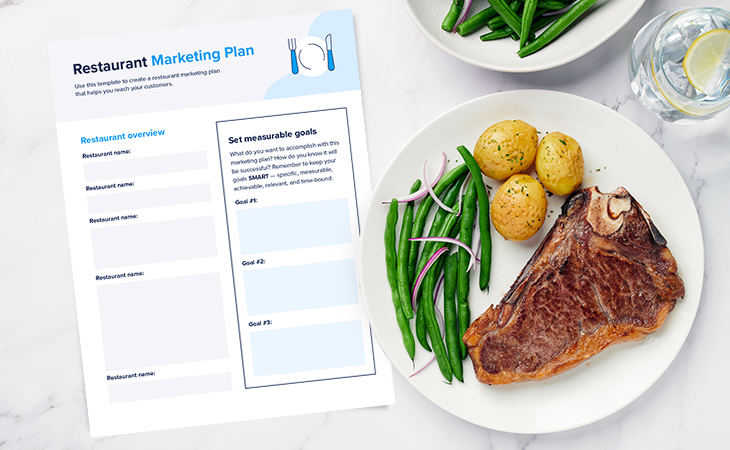
With our template, the most challenging part of creating a restaurant marketing plan is finding the time to develop it. Once you have one in place, you can easily update it annually so it grows as your restaurant does.
ZoomShift is there to help with all your restaurant needs, from getting your restaurant license to managing your restaurant and scheduling your employees.
JD enjoys teaching people how to use ZoomShift to save time spent on scheduling. He’s curious, likes learning new things everyday and playing the guitar (although it’s a work in progress).

